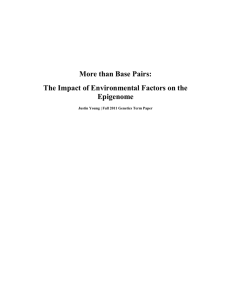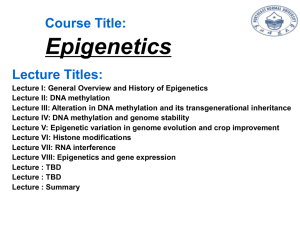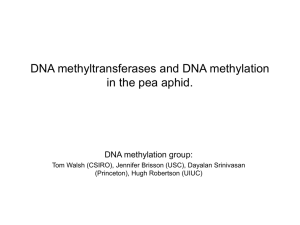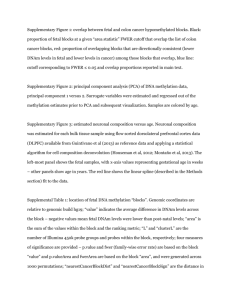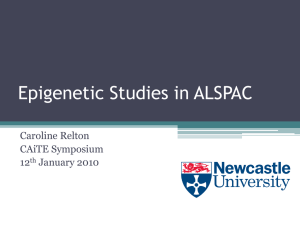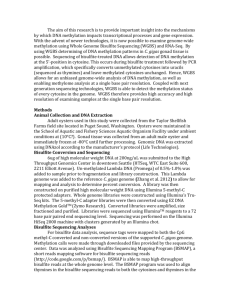Bivalve_Review5_Revision 110KB Oct 29 2013 01
advertisement
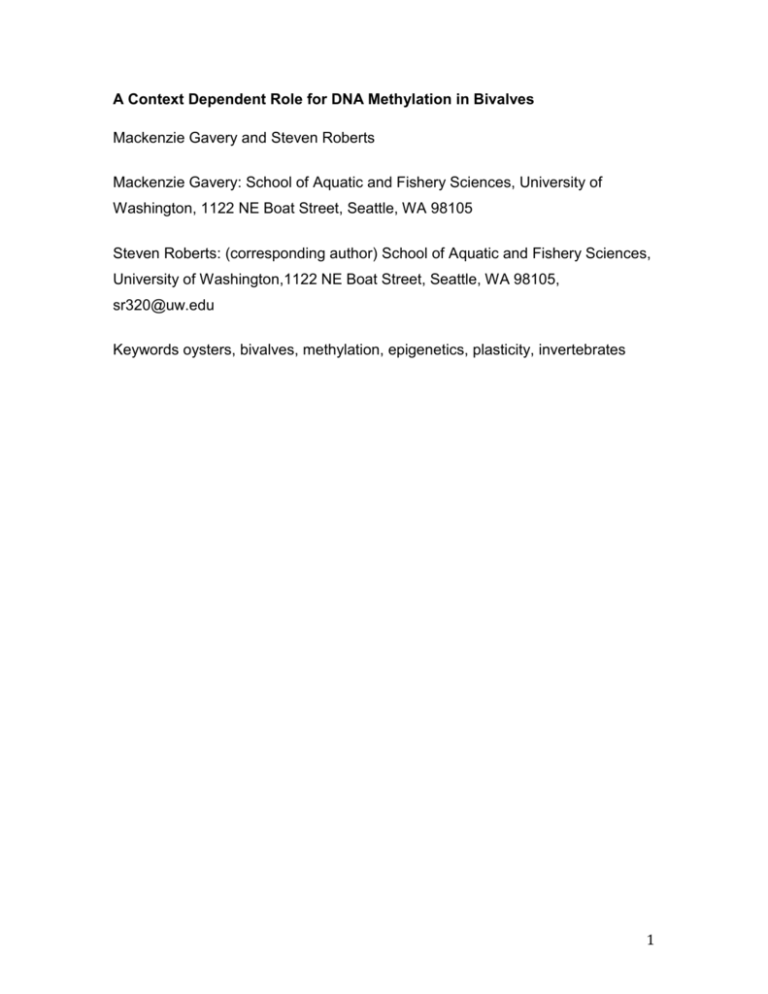
A Context Dependent Role for DNA Methylation in Bivalves
Mackenzie Gavery and Steven Roberts
Mackenzie Gavery: School of Aquatic and Fishery Sciences, University of
Washington, 1122 NE Boat Street, Seattle, WA 98105
Steven Roberts: (corresponding author) School of Aquatic and Fishery Sciences,
University of Washington,1122 NE Boat Street, Seattle, WA 98105,
sr320@uw.edu
Keywords oysters, bivalves, methylation, epigenetics, plasticity, invertebrates
1
A Context Dependent Role for DNA Methylation in Bivalves
Mackenzie Gavery and Steven Roberts
Mackenzie Gavery is a PhD candidate in the School of Aquatic and Fishery
Sciences at the University of Washington. She is interested in understanding how
epigenetic mechanisms mediate environmental signaling and adaptation in
bivalves.
Steven Roberts is an Associate Professor in the School of Aquatic and Fishery
Sciences at the University of Washington where his lab focuses on characterizing
physiological responses of marine organisms to environmental change.
Keywords oysters, bivalves, methylation, epigenetics, plasticity, invertebrates
Abstract: The function of DNA methylation in species such as bivalves where the
limited amount of DNA methylation is predominantly found in gene bodies
remains unclear. An emerging possible explanation is that the role of gene body
DNA methylation is dependent on gene function, a potential phenomenon that
has arisen from selective pressure on lineage-specific life history traits. In genes
contributing to phenotypes that benefit from increased plasticity, the absence of
DNA methylation could contribute to stochastic transcriptional opportunities and
increased transposable element activity. In genes where regulated control of
activity is essential, DNA methylation may also play a role in targeted, predictable
genome regulation. Here we review the current knowledge concerning DNA
methylation in bivalves and explore the putative role of DNA methylation in both
an evolutionary and ecological context.
2
The variability observed in DNA methylation landscapes and functionality in
invertebrates is fascinating from both a molecular and evolutionary perspective.
At the molecular level we are still uncovering the many nuances associated with
the functional mechanism of methylation, which in turn should eventually provide
insight into the evolution of this prevalent epigenetic mark. Although we continue
to understand more about DNA methylation in invertebrates, relatively limited
information exists concerning the role of DNA methylation in molluscs. The
phylum Mollusca encompasses xxx species represents diverse evolutionary
branch and stuff. Bivalves in particular are economically (commercial relevance
in aquaculture) and ecologically important (sentinel organisms) group. Here we
review the current knowledge concerning DNA methylation in bivalves and
explore the putative role of DNA methylation in both an evolutionary and
ecological context.
The presence of DNA methylation has been confirmed in several bivalves
including the Japanese scallop, Chlamys farreri [1], the salt water clam, Donax
trunculus [2], and the Pacific oyster Crassostrea gigas [3]. Using high-throughput
sequencing of bisulfite treated DNA (BS-Seq) it was recently determined 15% of
CpG dinucleotides (1.8% of total cytosines) in the C. gigas genome are
methylated (Gavery & Roberts in review), similar to the 2% total methylation for a
gastropod (snail) as measured by LC-MS [4]. Methylation levels reported for the
Pacific oyster were characterized in adult gill tissue but it is important to note that
methylation levels are likely to vary among life history stages and among tissue
types. This point is clearly indicated by Riviere et al [5] where they used an
ELISA to quantify relative DNA methylation in developing oysters. Although the
ELISA approach does not provide comparable values with respect to the extent
of absolute DNA methylation levels, methylation almost doubled during the
morula and blastula stage as compared to oocyte and then decreased again
during later developmental stages [5].
DNA methylation in bivalves appears to be predominantly found in gene bodies
(Gavery & Roberts, in review). The observation that gene bodies are the primary
3
methylated genomic feature is consistent with what has been described in other
invertebrates (e.g. [6–8] There is increasing evidence that this form of
methylation is the ancestral pattern [9] as gene body methylation is observed not
only in invertebrates and vertebrate species [10] but also in plants [11]. The
function of DNA methylation in species such as bivalves where the limited
amount of DNA methylation is predominantly found in gene bodies remains
unclear. One possible explanation that is emerging is that the role of gene body
DNA methylation is dependent on the gene function, a potential phenomenon
that has arisen from selective pressure on lineage-specific life history traits. In
genes whose function may benefit from increased variability (e.g. immune
response), the absence of DNA methylation contributes to stochastic
‘transcriptional opportunities’, whereas genes considered core to survival (e.g.
housekeeping genes) are protected from this type of transcriptional variation by
the presence of DNA methylation [12]. This theory of beneficial stochastic
variation as a result of hypomethylation could also be extended to other regions
of the genome such as transposable elements. Further, and not mutually
exclusively, DNA methylation may also play a role in a directed and targeted
genome regulation. It should also be noted that an alternative explanation for
intra-genic DNA methylation patterns is that it is solely a byproduct of having an
open and accessible chromatin state [13]. Here we will explore studies of both
stochastic and targeted methylation functions that are emerging as potential roles
for DNA methylation in bivalves.
Stochastic Variation
A classical explanation of gene body methylation is that it reduces transcriptional
noise by preventing initiation of transcription outside of traditional transcription
start sites (TSS) [14]. There are data to support this explanation in mammals
[15], though to our knowledge, this idea has not been tested directly in an
invertebrate. The implication of this explanation is that unmethylated regions
would be inherently ‘noisier’. It has been proposed that this type of ‘noise’ could
result in more diverse transcriptional opportunities [12], which may be beneficial
4
for organisms such as marine bivalves that live in unpredictable and variable
nearshore habitats, and as a result, have unpredictable and variable reproduction
and recruitment success. As such, oysters may use epigenetic systems to
maintain the genomic and phenotypic diversity necessary for a species that
undergoes this type of ‘sweepstakes reproduction’ [16] where chance events
dictate which individuals are successful each spawning season. The lack of
methylation, by allowing more transcriptional opportunities in genes functionally
associated with environmental response, may contribute to phenotypic plasticity
by providing access for transcription factors to bind to alternative transcription
start sites, facilitating exon skipping or other alternative splicing mechanisms,
and/or through unknown mechanisms supporting increased sequencing variation
[12]. Although direct evidence is currently lacking to support the idea that hypomethylation is correlated with increased transcriptional opportunities in bivalves,
recent evidence is concordant with this possibility in insects. Specifically, in the
honeybee A. mellifera, knockdown of global methylation was associated with
increased transcriptional opportunities in the form of the generation of splice
variants [17] .
Consistent with the theory that limited methylation allows for a variety of
transcriptional opportunities is the possibility that transposable element (TE)
mobilization may be facilitated by the lack of repressive DNA methylation in
bivalves. In vertebrates and some plants, extensive methylation of TEs
suppresses their activity in the genome [18]. In invertebrates, species such as A.
mellifera show very little methylation in TEs [8]. Likewise, in oysters there
appears to be no preponderance of TE methylation (Gavery and Roberts, in
review). The finding that TEs are not methylated in oysters is consistent with the
theory outlined above regarding the ability of a population to present a variety of
phenotypes in response to environment change (i.e. phenotypic plasticity). Thus
the absence of TE methylation may indicate an evolutionary pressure to retain
the variation generated by TE mobilization to maintain genetic diversity in a
species inhabiting heterogeneous environments [19].
5
It is worth considering the relationships between DNA methylation, TEs and
transcriptional / genomic variation in light of recent evidence coming from studies
of DNA methylation and stress response in plants. For example, it has recently
been reported that DNA methylation is involved in regulating the defense
response of Arabidposis thaliana to the pathogen Pseudomonas syringae [20].
Using mutant strains of A. thaliana defective in the various types of DNA
methylation, Dowen and colleagues were able to show that genome-wide
hypomethylation increased plant resistance to the pathogen and was associated
with mobilization of TEs and disregulaton of several immune response genes.
This was further examined by Yu and colleagues [21] where Arabidposis subject
to bacterial challenge exhibited globally reduced DNA methylation. This resulting
hypomethylation was associated with the reactivation of previously silent TEs.
The authors conclude that the defense response in A. thaliana is negatively
regulated by DNA methylation, and propose that hypomethylation is a part of the
plant immune response that acts by priming transcriptional activation of defense
genes that are linked to TEs. Considering these studies as a whole, it is
interesting that oysters, like plants, which are immobile and face intense
selection at early life stages, may benefit from these ‘noisy’ or ‘unstable’
genomes. It is important to note that the lack of DNA methylation does not
preclude TE silencing, which can be repressed by a variety of epigenetic
mechanisms (reviewed [22]). Future investigation in bivalves should focus on
characterizing these additional epigenetic marks (e.g. histone modification,
noncoding RNAs) to determine what roles they might play in stabilizing bivalve
genomes, and examining the relationship between TE activity and environmental
stress.
Targeted Regulation
A second explanation regarding a role for DNA methylation as it pertains to gene
body methylation in bivalves is that the epigenetic mark regulates transcriptional
activity in a targeted, predictable manner. Evidence is emerging linking gene
body methylation to a potential function in regulating alternative splicing [23,24].
6
The production of both constitutive and alternative isoforms by alternative
splicing is important for developmental processes and tissue-specific functions.
In oysters, alternative splicing regulates the generation of both tissue-specific
[25] and stress activated [26] isoforms of genes. The relationship between
methylation and splicing has been examined in a number of studies performed in
Apis mellifera [8,17,27]. Mechanistically, it has been proposed that exon specific
DNA methylation may impact exon-skipping through interactions with DNA
binding proteins (CTCF) and subsequent effects on RNA polymerase II pausing
[24]. Interestingly, although intronic methylation is rare in A. mellifera, Foret et al.
[27] identified a relationship between differential methylation in an intron
upstream of a differentially expressed cassette exon of the ALK gene.
Specifically, they reported that low methylation was correlated with high inclusion
of the upstream exon [27].
Additional support for a targeted role in regulating transcription in bivalves is the
recent work of Riviere et al [5]. Investigators examined the relationship between
expression and methylation in homeobox (hox) genes, a family of genes that are
critical developmental genes. Riviere et al. [5] observed an inverse relationship
with gene body methylation and expression, and hypothesized that the apparent
suppression of hox expression by DNA methylation was due to a “CpG islandlike” repression by DNA methylation proximal to the transcription start site (TSS)
in these genes. Results were obtained using methylated DNA
immunoprecipitation (MeDIP) qPCR, so the context of the region investigated
was known. When possible (6 out of 10 genes) the region examined was in the
1st exon or 5’UTR. The trend is similar to repression in proximal promoter/1st
exon repression as seen in mammals. Riviere et al [5] not only provide evidence
of active regulation of transcription via gene body methylation, but their work also
suggests mechanism similar to the conventional repressive nature of promoter
methylation in vertebrates. While little research exists on the relationship of
promoter methylation and expression in invertebrates, there is at least one report
in molluscs. In Aplysia, Rajasethupathy et al [28] found that serotonin exposure
7
induced an increase in methylation in the promoter of the CREB2 gene, which is
also associated with the downregulation of CREB2 mRNA in neurons. In general,
CpG island containing promoter methylation is not typical in invertebrates [7];
however it is possible that depending on the context of the methylation (i.e.
whether gene body or promoter methylation) it may play either a repressive or
expressive role. This is known as the DNA methylation paradox [29] and has
been observed in a wide range of taxa.
Future Direction
Continued endeavors exploring the role of DNA methylation in invertebrates will
certainly shed light on general similarities and lineage specific nuances. There
remains a multitude of research questions and phenomena that need attention;
among them are some of the ideas presented here. The only direct evidence
available relating DNA methylation and expression in bivalves focuses on a
single family of genes [5]. A draft genome of C. gigas is now available [30] and
new bivalve genomic resources are increasingly available to the scientific
community, allowing us to characterize stochastic versus targeted roles for DNA
methylation in bivalves. To ultimately gain a better understanding of this, future
studies are needed to characterize genome wide methylation and gene
expression on individuals with consideration towards cell-type, developmental
stage, and environmental condition. Future investigations into other epigenetic
phenomena, including histone modifications and non-coding RNAs, will provide a
fuller picture regarding genome regulation in bivalves.
Another important question is the extent that the environment influences DNA
methylation in bivalves. In other species it has been clearly shown that DNA
methylation can be influenced by the environment [31–33]. Interestingly, one of
the best examples of this phenomenon comes from findings in an invertebrate. In
honeybees, larvae fed royal jelly become queens, which are phenotypically
distinct from workers. It has been shown that DNA methylation serves as an
intermediary between this environmental signal (nutrition) and the developmental
8
outcome into a queen or a worker [34]. It is a likely generality that the
environment influences DNA methylation in bivalves, though possibly in a
different fashion, in light of the ideas presented here with respect to the
stochastic nature of new transcriptional opportunities and local adaptation.
It remains to be determined to what extent transgenerational epigenetic
inheritance occurs in invertebrate taxa. In mammals, evidence exists of
transgenerational inheritance of DNA methylation patterns and phenotypes in
response to certain xenobiotics (e.g. [35,36]). Transgenerational inheritance of
DNA methylation patterns associated with phenotypes (epialleles) have also
been observed in plants [37,38], including evidence that environmental stress
induces heritable changes [39]. C. elegans [40]. Transgenerational epigenetic
effects have not been investigated in bivalves, but one particularly intriguing
possibility to explore is the role of DNA methylation in protecting future
generations through an acquired stress response. Bivalves are generally sessile
and do not directly interact with their offspring. One way a bivalve could ‘inform’
their offspring about recent environmental conditions is through the transmission
of epigenetic marks such as DNA methylation.
If epigenetic marks are heritable, they may play a role in evolutionary processes.
To address the question of heritability, we need to compare levels of existing
epigenetic variation in natural populations with genetic variation. This indeed
could be a game changer, as epigenetic variation may offer a new platform for
selection. There has been some work done in vertebrates and plants [41–43],
though information in invertebrates is limited. Researchers have started to
address this fact in oyster aquaculture settings in response to mass selection
protocols. Jiang et al [44] used a methylation-sensitive amplified polymorphism
(MSAP) methodology to identify epigenetic variation between a base population
and a fourth generation mass selection population. They also used AFLP to look
at genetic variation. Jiang et al [44] found genetic variation with no epigenetic
variation over all, though specific differences were observed. The authors
observed a correlation between epigenetic and genetic variation. Despite the
9
limitations of this study in using a relatively small number of random markers, it is
the first study comparing epigenetic and genetic variation in bivalves and
illuminates an interesting direction for future work.
The relationship of heritable transmission of genome patterns and epigenetic
resetting is another research avenue that should be explored. In mammalian
systems epigenetic resetting, a clearing and re-establishment of DNA
methylation with each generation, is thought to be necessary to induce
pluripotency of cells (reviewed - [45]). Nevertheless, there are certain loci (e.g.
imprinted genes) where the clearing of epigenetic marks is incomplete resulting
in meiotic inheritance of DNA methylation patterns. This type of transgenerational
inheritance has been studied in plants and mammals, but to our knowledge has
yet to be addressed in invertebrates. As mentioned above, oysters show
temporal changes in the total amount of DNA methylation during embryonic
development, with lower methylation in the 2-4 cell stages and increasing in
morula and blastula [5]. This observation may be indicative of an epigenetic
resetting event. However, characterizing epigenetic changes at finer temporal
time scales are needed.
Exploring these questions of epigenetic flexibility to environmental cues, natural
variation, heritability, as well as the possibility of epigenetic resetting in bivalves
will inform the direction of much larger research questions. Maybe add sentence
about experimental methodology? While we are gaining a better understanding
of invertebrate epigenetics, we certainly have a lot more to learn, which could
considerably change our comprehension of organismal and ecosystem
responses to environmental change.
Key Points
- DNA methylation is found throughout the genome and is predominant in
gene bodies in bivalves.
10
- The role of gene body DNA methylation could be dependent on the gene
function and serve to both reduce stochastic transcriptional noise as well
as regulate activity in a targeted manner.
- Several important research questions remain unanswered with respect to
DNA methylation in bivalves related to environmental influence,
relationship with genetic variation, and transgenerational inheritance.
REFERENCES
1. Wang S, Bao Z, Hu X, et al. Two novel elements (CFG1 and PYG1) of Mag
lineage of Ty3/Gypsy retrotransposons from Zhikong scallop (Chlamys farreri)
and Japanese scallop (Patinopecten yessoensis). Genetica 2008; 133:37–46
2. Petrovic V, Perez-Garcia C, Pasantes JJ, et al. A GC-rich satellite DNA and
karyology of the bivalve mollusk Donax trunculus: a dominance of GC-rich
heterochromatin. Cytogenet Genome Res 2009; 124:63–71
3. Gavery MR, Roberts SB. DNA methylation patterns provide insight into
epigenetic regulation in the Pacific oyster (Crassostrea gigas). BMC genomics
2010; 11:483
4. Fneich S, Dheilly N, Adema C, et al. 5-methyl-cytosine and 5-hydroxy-methylcytosine in the genome of Biomphalaria glabrata, a snail intermediate host of
Schistosoma mansoni. Parasites & Vectors 2013; 6:167
5. Riviere G, Wu G-C, Fellous A, et al. DNA Methylation Is Crucial for the Early
Development in the Oyster C. gigas. Marine Biotechnology 2013; 1–15
6. Simmen MW, Bird AP. Sequence analysis of transposable elements in the sea
squirt, Ciona intestinalis. Mol Biol Evol 2000; 17:1685–1693
7. Zemach A, McDaniel IE, Silva P, et al. Genome-Wide Evolutionary Analysis of
Eukaryotic DNA Methylation. Science 2010; 328 :916–919
8. Lyko F, Foret S, Kucharski R, et al. The Honey Bee Epigenomes: Differential
Methylation of Brain DNA in Queens and Workers. PLoS Biology 2010;
8:e1000506
9. Lechner M, Marz M, Ihling C, et al. The correlation of genome size and DNA
methylation rate in metazoans. Theory in Biosciences 2013; 132:47–60
11
10. Aran D, Toperoff G, Rosenberg M, et al. Replication timing-related and gene
body-specific methylation of active human genes. Human Molecular Genetics
2011; 20 :670–680
11. Zilberman D, Gehring M, Tran RK, et al. Genome-wide analysis of
Arabidopsis thaliana DNA methylation uncovers an interdependence between
methylation and transcription. Nat Genet 2007; 39:61–69
12. Roberts SB, Gavery MR. Is There a Relationship between DNA Methylation
and Phenotypic Plasticity in Invertebrates? Frontiers in physiology 2012; 2:116
13. Jjingo D, Conley AB, Yi S V, et al. On the presence and role of human genebody DNA methylation ABSTRACT. Oncotarget 2012; 3:462–474
14. Bird AP. Gene number, noise reduction and biological complexity. Trends
Genet 1995; 11:94–100
15. Huh I, Zeng J, Park T, et al. DNA methylation and transcriptional noise.
Epigenetics & Chromatin 2013; 6:9
16. Hedgecock D. Does variance in reproductive success limit effective
population sizes of marine organisms? Genetics and Evolution of Aquatic
Organisms. 1994; 122–134
17. Li-Byarlay H, Li Y, Stroud H, et al. RNA interference knockdown of DNA
methyl-transferase 3 affects gene alternative splicing in the honey bee.
Proceedings of the National Academy of Sciences 2013; 110 :12750–12755
18. Yoder JA, Walsh CP, Bestor TH. Cytosine methylation and the ecology of
intragenomic parasites. Trends in Genetics 1997; 13:335–340
19. Casacuberta E, González J. The impact of transposable elements in
environmental adaptation. Molecular Ecology 2013; 22:1503–1517
20. Dowen RH, Pelizzola M, Schmitz RJ, et al. Widespread dynamic DNA
methylation in response to biotic stress. Proceedings of the National Academy of
Sciences 2012; 109 :E2183–E2191
21. Yu A, Lepère G, Jay F, et al. Dynamics and biological relevance of DNA
demethylation in Arabidopsis antibacterial defense. Proceedings of the National
Academy of Sciences 2013; 110 :2389–2394
22. Slotkin RK, Martienssen R. Transposable elements and the epigenetic
regulation of the genome. Nat Rev Genet 2007; 8:272–285
12
23. Maunakea AK, Nagarajan RP, Bilenky M, et al. Conserved role of intragenic
DNA methylation in regulating alternative promoters. Nature 2010; 466:253–257
24. Shukla S, Kavak E, Gregory M, et al. CTCF-promoted RNA polymerase II
pausing links DNA methylation to splicing. Nature 2011; 479:74–79
25. Rodet F, Lelong C, Dubos M-P, et al. Alternative splicing of a single
precursor mRNA generates two subtypes of Gonadotropin-Releasing Hormone
receptor orthologues and their variants in the bivalve mollusc Crassostrea gigas.
Gene 2008; 414:1–9
26. Guévélou E, Huvet A, Sussarellu R, et al. Regulation of a truncated isoform
of AMP-activated protein kinase α (AMPKα) in response to hypoxia in the muscle
of Pacific oyster Crassostrea gigas. Journal of Comparative Physiology B 2013;
183:597–611
27. Foret S, Kucharski R, Pellegrini M, et al. DNA methylation dynamics,
metabolic fluxes, gene splicing, and alternative phenotypes in honey bees.
Proceedings of the National Academy of Sciences 2012; 109 :4968–4973
28. Rajasethupathy P, Antonov I, Sheridan R, et al. A Role for Neuronal piRNAs
in the Epigenetic Control of Memory-Related Synaptic Plasticity. Cell 2012;
149:693–707
29. Jones PA. The {DNA} methylation paradox. Trends in Genetics 1999; 15:34–
37
30. Fang X, Li L, Lou R, et al. Genomic data from the Pacific oyster (Crassostrea
gigas). GigaScience 2012;
31. Chinnusamy V, Zhu J. Epigenetic regulation of stress responses in plants.
Current Opin Plant Biol 2009; 12:133–139
32. Navarro-Martín L, Viñas J, Ribas L, et al. DNA Methylation of the Gonadal
Aromatase (cyp19a) Promoter Is Involved in Temperature-Dependent Sex Ratio
Shifts in the European Sea Bass. PLoS Genet 2011; 7:e1002447
33. Yu Y, Yang X, Wang H, et al. Cytosine Methylation Alteration in Natural
Populations of Leymus chinensisInduced by Multiple Abiotic Stresses. PLoS
ONE 2013; 8:e55772
34. Kucharski R, Maleszka J, Foret S, et al. Nutritional Control of Reproductive
Status in Honeybees via DNA Methylation. Science 2008; 319 :1827–1830
35. Manikkam M, Guerrero-Bosagna C, Tracey R, et al. Transgenerational
Actions of Environmental Compounds on Reproductive Disease and
13
Identification of Epigenetic Biomarkers of Ancestral Exposures. PLoS ONE 2012;
7:e31901
36. Guerrero-Bosagna C, Settles M, Lucker B, et al. Epigenetic
Transgenerational Actions of Vinclozolin on Promoter Regions of the Sperm
Epigenome. PLoS ONE 2010; 5:e13100
37. Cubas P, Vincent C, Coen E. An epigenetic mutation responsible for natural
variation in floral symmetry. Nature 1999; 401:157–161
38. Manning K, Tor M, Poole M, et al. A naturally occurring epigenetic mutation in
a gene encoding an SBP-box transcription factor inhibits tomato fruit ripening.
Nat Genet 2006; 38:948–952
39. Verhoeven KJF, Jansen JJ, van Dijk PJ, et al. Stress-induced DNA
methylation changes and their heritability in asexual dandelions. New Phytologist
2010; 185:1108–1118
40. Nice HE, Morritt D, Crane M, et al. Long-term and transgenerational effects of
nonylphenol exposure at a key stage in the development of Crassostrea gigas.
Possible endocrine disruption? Marine Ecology Progress Series 2003; 256:293–
300
41. Liu S, Sun K, Jiang T, et al. Natural epigenetic variation in the female great
roundleaf bat (Hipposideros armiger) populations. Molecular Genetics and
Genomics 2012; 287:643–650
42. Schrey AW, Coon CAC, Grispo MT, et al. Epigenetic variation may
compensate for decreased genetic variation with introductions: a case study
using house sparrows (Passer domesticus) on two continents. Genetics research
international 2012; 2012:
43. Herrera CM, Bazaga P. Epigenetic differentiation and relationship to adaptive
genetic divergence in discrete populations of the violet Viola cazorlensis. New
Phytologist 2010; 187:867–876
44. Jiang Q, Li Q, Yu H, et al. Genetic and epigenetic variation in mass selection
populations of Pacific oyster Crassostrea gigas. Genes & Genomics 2013; 1–7
45. Santos F, Dean W. Epigenetic reprogramming during early development in
mammals. Reproduction 2004; 127 :643–651
14


